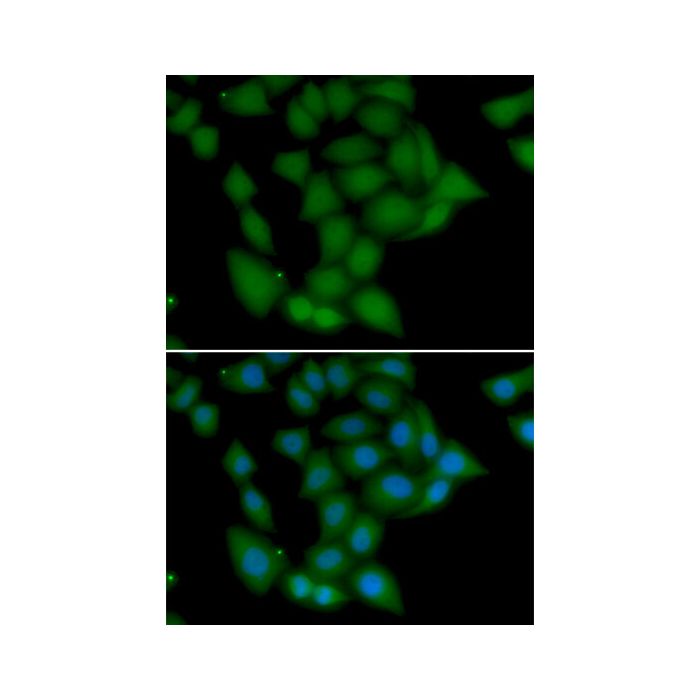CaMKIα polyclonal, anti-human, mouse, rat
€388.00
In stock
SKU
BS8651
Background:
The Ca2+/calmodulin-dependent protein kinases (CaM kinases) comprise a structurally related subfamily of serine/threonine kinases which include CaMKI, CaMKII and CaMKIV. CaMKII is a ubiquitously expressed serine/threonine protein kinase that is activated by Ca2+ and calmodulin (CaM) and has been implicated in regulation of the cell cycle and transcription. There are four CaMKII isozymes, designated α, β, γ and δ, which may or may not be coexpressed in the same tissue type. CaMKIV is stimulated by Ca2+ and CaM but also requires phosphorylation by a CaMK for full activation. Stimulation of the T cell receptor CD3 signaling complex with an anti-CD3 monoclonal, leads to a 10-40 fold increase in CaMKIV activity. An additional kinase, CaMKK, functions to activate CaMKI through the specific phosphorylation of the regulatory threonine residue at position 177.
Alternative Name:
CaM K1, CaM KI, CaM kinase 1 alpha, CAM kinase 1, CaM kinase I alpha, CAM kinase I, CaMK 1, CAMK I, CaMK1 alpha, CaMK1, CAMK1 PEN, CaMKI alpha, MGC120317, MGC120318,
Application Dilution: WB: 1:500~1:2000, IF: 1:50~1:200
Specificity: CaMKIα polyclonal antibody detects endogenous levels of CaMKIα protein.
Immunogen:
Recombinant full length Human CaMKIα.
MW: ~ 41kDa
Swis Prot.: Q14012
Purification & Purity:
The antibody was affinity-purified from rabbit antiserum by affinity-chromatography using epitope-specific immunogen and the purity is > 95% (by SDS-PAGE).
Format:
1mg/ml in PBS with 0.1% Sodium Azide, 50% Glycerol.
Storage:
Store at 4°C short term. Aliquot and store at -20°C long term. Avoid freeze-thaw cycles.
For research use only, not for use in diagnostic procedure.
The Ca2+/calmodulin-dependent protein kinases (CaM kinases) comprise a structurally related subfamily of serine/threonine kinases which include CaMKI, CaMKII and CaMKIV. CaMKII is a ubiquitously expressed serine/threonine protein kinase that is activated by Ca2+ and calmodulin (CaM) and has been implicated in regulation of the cell cycle and transcription. There are four CaMKII isozymes, designated α, β, γ and δ, which may or may not be coexpressed in the same tissue type. CaMKIV is stimulated by Ca2+ and CaM but also requires phosphorylation by a CaMK for full activation. Stimulation of the T cell receptor CD3 signaling complex with an anti-CD3 monoclonal, leads to a 10-40 fold increase in CaMKIV activity. An additional kinase, CaMKK, functions to activate CaMKI through the specific phosphorylation of the regulatory threonine residue at position 177.
Alternative Name:
CaM K1, CaM KI, CaM kinase 1 alpha, CAM kinase 1, CaM kinase I alpha, CAM kinase I, CaMK 1, CAMK I, CaMK1 alpha, CaMK1, CAMK1 PEN, CaMKI alpha, MGC120317, MGC120318,
Application Dilution: WB: 1:500~1:2000, IF: 1:50~1:200
Specificity: CaMKIα polyclonal antibody detects endogenous levels of CaMKIα protein.
Immunogen:
Recombinant full length Human CaMKIα.
MW: ~ 41kDa
Swis Prot.: Q14012
Purification & Purity:
The antibody was affinity-purified from rabbit antiserum by affinity-chromatography using epitope-specific immunogen and the purity is > 95% (by SDS-PAGE).
Format:
1mg/ml in PBS with 0.1% Sodium Azide, 50% Glycerol.
Storage:
Store at 4°C short term. Aliquot and store at -20°C long term. Avoid freeze-thaw cycles.
For research use only, not for use in diagnostic procedure.
| Is Featured? | No |
|---|
Write Your Own Review

